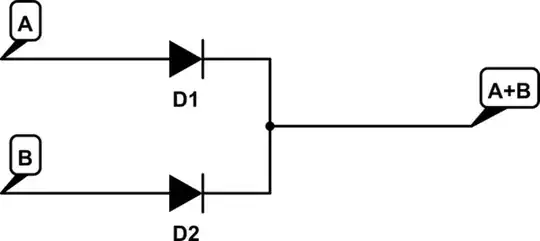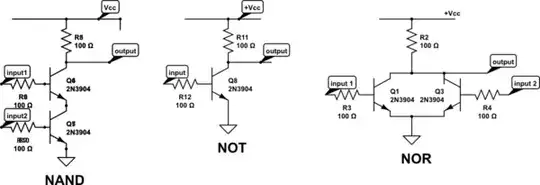Why do NAND and NOR gates require two transistors each, whereas AND and OR gates require three each?
-
3Because an inverter requires 1 transistor. – Ignacio Vazquez-Abrams Feb 13 '14 at 19:24
-
Could you give some example circuits of the technology you are actually referring to. DTL,RTL,TTL,CMOS? – JIm Dearden Feb 13 '14 at 19:56
-
1In CMOS (the most common digital IC technology) NAND, NOR require 4 MOSFETs whereas AND, OR require 6. AND, OR are made by adding an inverter (2 MOSFETs) to a NAND, NOR gate. – akellyirl Feb 14 '14 at 12:19
4 Answers
The premise of your question is false. Here's an OR gate with zero transistors and two diodes:

simulate this circuit – Schematic created using CircuitLab
This isn't an especially good OR gate, but it is one. It doesn't have any voltage gain, for starters.
It can be the case that some logic designs require three transistors for an OR gate. This isn't anything intrinsic to an OR gate: it's just how that particular logic was designed. For whatever design goals the logic had, three transistors was the best way to do it.
- 57,310
- 18
- 145
- 267
Your question appears to be premised on the use of an NPN transistor as the fundamental switching element used to construct the logic gate or function. Ubuntu_noob has shown the three functions (NAND, NOT, NOR ) created with NPN-only devices.
However, if the fundamental element is changed from an NPN transistor to a PNP transistor, or NMOS transistor, or PMOS transistor, or CMOS (pairs of NMOS & PMOS transistors), or even diodes, you will find that a different number of those fundamental elements will be needed to form the basic logic functions. In some of these systems the OR or NOR function are "natural" and require the least number of elements to implement (e.g. the Diode OR function Phil Frost provided). In others, the AND or NAND function would require the minimum number of elements to implement. So, it is not universally true that NOR & NAND functions require two transistors, or three for AND & OR. It depends on the fundamental switching element utilizied.
You are likely most familiar with TTL-like logic families which utilize on-chip NPN transistors. Or, with constructing logic functions from discrete transistors in which case NPNs are the type most frequently utilized. ( PNP's "missed the boat" for popular use in discrete logic implementation a few decades ago because of cost, so NPNs became the traditional choice, enforced by decades of examples in text books, magazine articles, on-line tutorials, etc.)
- 2,694
- 15
- 13
-
+1, but I'd point out you can also make an OR gate with just two NPN transistors. Simply take my circuit, and replace the diodes with base-emitter junctions, and tie the collectors to Vcc. You don't necessarily need to use a different class of components: you just need to connect them differently. – Phil Frost Feb 13 '14 at 20:50
It is the nature of the typical transistor to invert a signal. NAND and NOR with two inputs have an overall effect of inverting their inputs (imagine tying the two inputs together to be one input) so they can be done with one transistor per input.
For AND or OR gates, an extra inverter is needed - like "Two wrongs make a right" so that takes an extra inverter. Each input must pass through two transistors.
This is assuming the simplest design, using the minimum number of transistors in switching mode, as an amplifier whose output swings from Vcc to gnd (or as close as it can get.) Faster logic will have more transistors, some to pull up the output voltage and some to pull it down. So don't take the transistor count seriously - but the fundamental idea of inverters and needing more transistors for AND and OR logic still holds.
- 4,060
- 1
- 25
- 37

simulate this circuit – Schematic created using CircuitLab
I have drawn the approximate circuits for you. Please do the math.
- 656
- 1
- 8
- 22
-
Connect the output of the shown NAND gate to the input of the NOT gate and you have your 3 transistor AND. Connect the output of your NOR gate to the input of your NOT gate and you have your 3 transistor OR. Hence, NAND and NOR are 2 transistor logic operators whereas AND and OR are 3 transistor logic operands. – ubuntu_noob Feb 14 '14 at 08:50